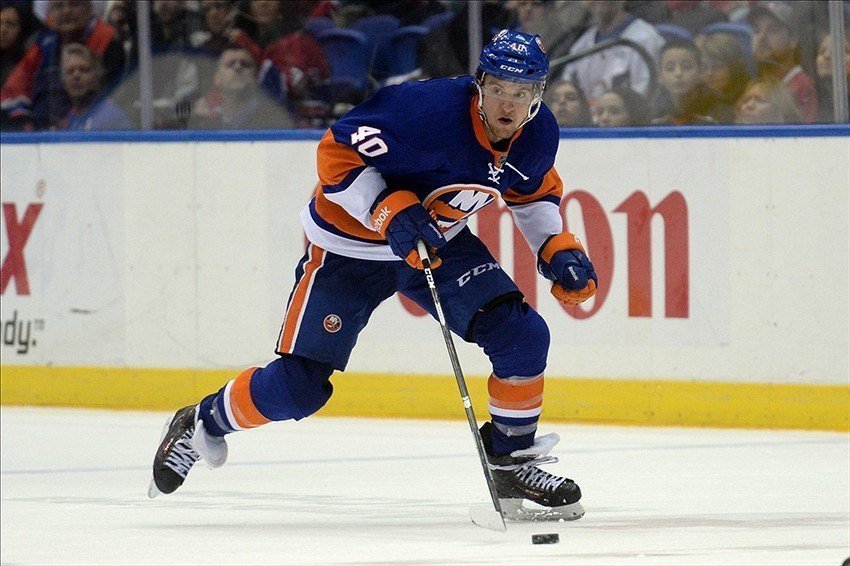Looking at yesterday’s trade for Michael Grabner, a quick reaction might have been to think “wow, that’s a lot of young players to give up,” given how many prospects headed to New York in the deal.
It’s only natural to expect Toronto would get another prospect or late draft pick back, but the fact that they gave up a good quantity of players is a part of why the deal was made from Toronto’s perspective. As Bob McKenzie was quick to point out, the Leafs were facing a problem being near the upper limit of 50 standard player contracts. This trade solved that problem by shedding players who were taking up spaces and were far enough down the depth chart that there would be minimal impact to the Leafs roster. Yet, because of the sheer number of prospects it cost, the Grabner deal might bring about questions as to the soundness of the asset management. After all, there is always something attractive about a young player who might pan out.
To reconcile the dissonance between thinking ‘we gave up too much’ with practical roster implications, it’s helpful to distinguish between two approaches to evaluating player transactions: asset management and roster management. Let’s start with some quick definitions.
Asset management involves extracting maximum value in every trade. GMs who are great at asset management are ones who can get an extra draft pick or prospect in any deal, or who can convince a trade partner to surrender a third round pick instead of a fourth. A classic example is the trade that sent Denis Savard from Chicago to Montreal in exchange for Chris Chelios. Say what you will about that trade, but the fact that Chicago managed to get a second round pick in addition to Chelios was great asset management.
In contrast, roster management is only concerned with the active roster. In this case, because it’s still the offseason, let’s consider the key outcome to be who will be on the roster as of opening night during the regular season.
I
Make no mistake, it was a great transaction in terms of roster management.
What we can learn from investment finance
Here’s where a financial metaphor becomes useful. When managing a portfolio or hedge fund – i.e. asset management in a traditional sense – there are one of two things you are looking to get out of it any time you make a trade.
Appreciation in value
The math here is simple: this is the net gain from selling something less whatever you originally paid. To use a hockey example, consider the first time the Leafs signed Daniel Winnik. Because he was a free agent signing, the cost was effectively zero (we’ll keep things simple and ignore things like salary paid, and the opportunity cost of using a roster space). When Toronto traded him to Pittsburgh for Zach Sill and two draft picks at the deadline, this was an obvious win from an asset management perspective. Here, the key is to think of players as assets you not only want to acquire, but also benefit from maximizing their exit value as well. Wendel Clark gave a lot to Leaf fans every night on the ice, but he also helped the team out off the ice when Cliff Fletcher traded him to bring a young Mats Sundin to town. As much as that deal was a tough one to make at the time, it also proves an important principle of expert asset management: this is not the time to be sentimental.
Holding period return (HPR)
This is the gain from an asset between when you buy it and sell it. With stocks, this is typically any dividend paid. With bonds, it comes in the form of coupon payments. So, if you buy and sell an asset for exactly the same price, is there any benefit for doing the deal? In some cases, yes. An easy example is the Blue Jays’ recent acquisition of pitcher David Price. The deal cost the team assets, and if Price leaves in the offseason as a free agent, that might seem like a loss. But the trade probably made the difference in helping the Jays qualify for postseason play. All in all, between added ticket sales, playoff revenues, a chance at contenting for a World Series, and a huge lift in the general level of excitement around Toronto, there were definitely benefits to the deal regardless of whether the Jays actually win the World Series. Another kind of HPR benefit involves player development. Take Martin St Louis for example: He played a key role in mentoring Steven Stamkos and helping him to get his career off to a great start. Then, as a New York Ranger, St. Louis helped Rick Nash get his game back on track. Even if the direct benefit is modest, being able to make players around you better can be a significant contribution.
Roster Management vs. Asset Management
Here are three ways the Grabner deal is a win from a roster management perspective:
It improves the active roster immediately.
A few days ago, Leaf Coach Mike Babcock expressed concern about Toronto’s offense: “Each year in Detroit, Ken Holland and myself, we add up the goals we’re going to score. We’d know before the year what we thought we were going to score. When I added up the goals the other day, they didn’t add up right. I tried to do it again and again, and I didn’t like the outcome.”
Babcock is just being honest here, recognizing the obvious downside of the earlier Kessel deal. Babcock admitted as much himself: “any time you move a guy like Phil, who is a high-high end scorer, you’re going to suffer to replace his goals. That’s just the reality of the situation.”
Gaining some of these goals back with Grabner, who can play minutes on the first and second line, will help here.
As for the cost, if this trade was just Taylor Beck for Grabner straight up, it would be a clear win for Toronto. From an active roster perspective, that is essentially what this deal is. Even though Grabner’s output has tailed off a bit in recent years, he remains a useful player with good hands and great wheels. He’s also exciting to watch. To get a sense of his scoring potential when he’s on his game, check out his stats in Sochi: Grabner tied for most goals scored in the tournament (with Phil Kessel, of all people, being the other) despite playing two fewer games and having significantly weaker linemates on Team Austria. Another major plus is his speed, as it’s well known Grabner has a reputation for being one of the fastest skaters in the league. According to optical tracking data, his skating ranks in the top 1% of the league, and he has elite acceleration. Incidentally, looking at how he compares to other speedsters, his numbers were closest to, but slightly faster than, Patrick Kane’s.
This opens the door for other roster upgrades.
As mentioned earlier, a key benefit of this trade is how it reduced the number of players under contract from 49 to 45. This is significant for a team with three proven NHL regulars seeking to win roster places from PTO contracts. As of two days ago, with only one contract under the maximum allowed, if two of Boyes, Glencross and Setoguchi impressed in camp, it wouldn’t be possible to add them to the roster without cutting a player or making a trade to free up space. Now, being able to add up to five new contracts gives Toronto more roster flexibility.
The other consideration is the question of whether Beck would even make the team. At forward, let’s assume most of the players from last year make the team (Kadri, Lupul, JVR, Bozak, Leo, Winnik, Holland and Panik). If you add Matthias and Parenteau to that list, you now have Boyes, Glencross, Setoguchi, Spaling, Arcobello, Casey Bailey and Taylor Beck fighting for one remaining spot. This is not even considering the possibility that Connor Brown or someone else from the Marlies has a strong preseason and pushes for a spot with the big club. Beck was going to need a great preseason just to be the last player to survive the final cut.
There was a good chance we were going to lose Beck for nothing soon anyway.
In the previous point, we discussed how Beck might not even make the team. Now let’s consider what happens if Beck did come close but still fell short. In that case, he could’ve helped bolster the roster on the Marlies, right? Not so fast. Beck is fairly young, but at age 24 he has enough games under his belt (over 60) to be no longer waiver exempt. So, there’s a pretty good chance that Toronto would lose him for nothing. Trading a guy you would likely lose soon on waivers, for a guy who should play in the top six, makes a lot of sense from a roster management perspective.
As for the prospects the Leafs gave up, they were way down the depth chart. If what Toronto gave up included Viktor Loov, Andreas Johnson or Connor Brown, it would obviously be a different story, but the guys Toronto traded way were expendable. Finn and Verhaeghe both underwhelmed in the rookie tournament. Given the depth of the Marlies roster, there is a decent chance that both of them could have started their season in Orlando. If that’s the case, why use up valuable contract slots on them?
Now let’s consider this trade from an asset management perspective.
Asset valuation and timing
A key concept that makes financial trades a good model to use thinking about player transactions is the idea that the value of an asset changes over time. There are two ways this happens. One involves seasonal effects (for example, convertibles sell for more money in the summer). Good real estate investors also have built sizeable fortunes timing buying and selling with broad market movements. In hockey, depth defencemen, who are cheap to acquire in the summer, bring back stronger returns near the trade deadline. A second timing effect occurs over the long term as an asset’s value increases, peaks, and then ultimately decays over time. Prospects usually have less value than proven all-stars, but older players become available at a discount after they reach their mid 30s and production declines. Holding on to an asset too long decreases trade value, which is a mistake the Leafs have made time and time again.
Considering exit value as part of the deal
Since Grabner is an unrestricted free agent after this season, it’s worth considering what he could bring back at the trade deadline. Generally, four types of players see abnormal increases in trade value at the trade deadline: depth defencemen, goalies, veteran leaders, and forwards who can score. Grabner could prove to be a good addition to a contender at the deadline. Anyone who was excited about what we could get for Matthias or any of the guys on PTO contracts should be even more excited now, because Grabner could bring back a better return than any of them. The chance to acquire an extra first or second round pick at the deadline is not an insignificant gain, especially during a period where the Leafs are still benefitting from a window of insider knowledge of OHL prospects, courtesy of Mark Hunter, Kyle Dubas and DJ Smith.
It’s important to recognize that neither approach – asset or roster management – is better than the other across all situations. At the draft, Leafs management made some great asset management moves when they converted a late first round pick (24th overall) into three prospects: Travis Dermott (34th), Jeremy Bracco (61st) and Martin Dzierkals (68th). Each approach has its advantages, and achieving a balance between the two is key. With Grabner, Toronto not only got the best player, they also didn’t lose any top prospects, gave up no draft picks, and solved the problem of being up against the maximum contracts limit.
Overall, the trade was a win for Toronto. It also sets up an attractive future trade opportunity at the deadline, at a minimal cost.

































